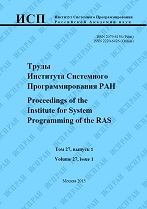|
Test generation for digital hardware based on high-level models
M. M. Chupilkoa, A. S. Kamkinabc, M. S. Lebedeva, S. A. Smolova
a Institute for System Programming of the Russian Academy of Sciences
b Lomonosov Moscow State University (MSU)
c Moscow Institute of Physics and Technology (MIPT)
Abstract:
Hardware testing is a process aimed at detecting manufacturing faults in integrated circuits. To measure test quality, two main metrics are in use: fault detection abilities (fault coverage) and test application time (test length). Many algorithms have been suggested for test generation; however, no scalable solution exists. In this paper, we analyze applicability of functional tests generated from high-level models for low-level manufacturing testing. A particular test generation method is considered. The input information is an HDL description. The key steps of the method are system model construction and coverage model construction. Both models are automatically extracted from the given description. The system model is a representation of the design in the form of high-level decision diagrams. The coverage model is a set of LTL formulae defining reachability conditions for the transitions of the extended finite state machine. The models are translated into the input format of a model checker. For each coverage model formula the model checker generates a counterexample, i.e. an execution that violates the formula (makes the corresponding transition to fire). The approach is intended for covering of all possible execution paths of the input HDL description and detecting dead code. Experimental comparison with the existing analogues has shown that it produces shorter tests, but they achieve lower stuck-at fault coverage comparing with the dedicated approach. An improvement has been proposed to overcome the issue.
Keywords:
digital hardware, hardware description language, manufacturing testing, stuck-at fault, high-level decision diagram, extended finite state machine, model checking, fault propagation.
Citation:
M. M. Chupilko, A. S. Kamkin, M. S. Lebedev, S. A. Smolov, “Test generation for digital hardware based on high-level models”, Proceedings of ISP RAS, 29:4 (2017), 247–256
Linking options:
https://www.mathnet.ru/eng/tisp247 https://www.mathnet.ru/eng/tisp/v29/i4/p247
|

| Statistics & downloads: |
| Abstract page: | 147 | | Full-text PDF : | 175 | | References: | 37 |
|




 Contact us:
Contact us: Terms of Use
Terms of Use
 Registration to the website
Registration to the website Logotypes
Logotypes









 Citation in format
Citation in format 